The MGA With An Attitude
INTRODUCTION to MGA Cars -- BUY-100
The MG Series MGA was produced from May 1955 to May 1962, totaling just over 100,000 units built. About two thirds of all MGA produced are 1500 model. The 1500 and 1600 engines are nearly identical except for the block and pistons (just a larger bore). All the rest of the 1500/1600 engine parts are the same and interchangeable. They both use the "15" head. The 1500 and 1600 crankshafts may have slightly different shape to the counterweights, but are otherwise interchangeable.
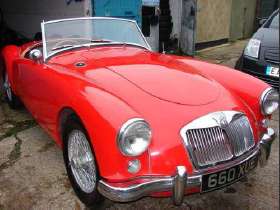

1500 model, small lights front and rear, optional wire wheels.
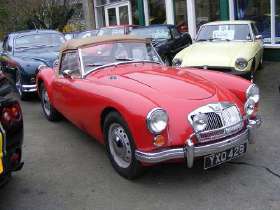

1600 model, larger lights front, dual lights rear, disc wheels, optional grill guard and luggage rack. (Driving lights are aftermarket type, not on factory brackets).
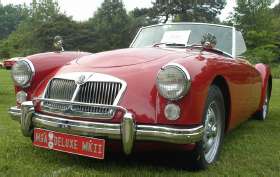

1600-MK-II model, larger lights front, horizontal lights rear, and recessed grill.
Knock-off steel wheels are part of Competition Suspension option.
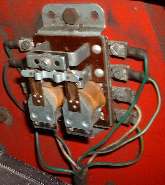
|
The 1500 car has single tail lights with dual filament bulb. The brake light and turn signal use the same filament in one bulb. To do this it has a dual relay to switch the brake lamps (one at a time) out of the brake circuit and onto the flasher circuit. The 1600 has an additional small round lamp for the turn signal (small round lamp above the other tail light lens). Having separate bulbs for tail light and brake light, it does not need the relay, so the wiring harnesses are different.
There were 5 different gearboxes. Early 1500 cars had 1-inch splined output shaft, straight dust cup on propshaft, and low starter position. Mid 1500 cars had 1-1/16-inch splined output shaft, flared dust cup on propshaft, and low starter position. Late 1500 cars had high starter position, flanged output shaft, and two-piece propshaft with sliding spline just aft of the front u-joint. This was carried over for all of 1600 production. Late production 1600-MK-II gearbox had more external ribbing on the case. All Twin Cam and some "Deluxe" cars had the 5th style gearbox with smooth case and a rectangular lump on top of the bellhousing. Most internal gearbox parts are interchangeable. There was an optional close ratio gear set available for competition work.
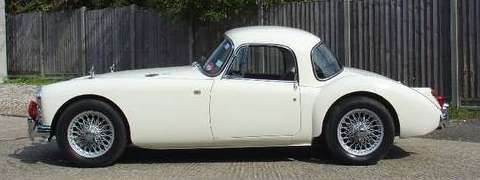
Coupe, roll up windows, door handles, wire wheels
Starting in mid 1500 production there was an MGA Coupe with a rounded roof shape, three window backlight, taller wrap around windscreen roll up windows and door handles. The Coupe dash has a different (straighter) shape to the bottom edge and (wrap around) ends, and vinyl covering on the dash and on the body cowl between the dash and windscreen. With the vinyl covered dash you get a chrome trim strip along the bottom edge and a bold chrome bezel surrounding the radio speaker grille and horn push button. The Coupe would have gray carpet and off-white headliner. The Coupe seat backs were level across the top rather than canted to match the body cowl curvature, and the pleating pattern was different from the roasters.
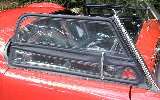

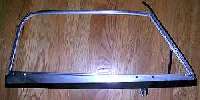
Side Curtains: 1500-type on left, 1600-type in center, hardtop type on right.
|
The 1600 (and 1600-MK-II) has front disc brakes where the 1500 has drum brakes all around. The 1500 and 1600 side curtains are (originally) different design (but interchangeable), always fabric covered when used with the rag top. 1500's started production with one-window rag top switching to 3-windows in September 1958. Other differences are quite minor, like the style of the front parking lamps, the nut securing the side curtains, different top on the master cylinder, and different badging on the outer body. In late 1600 production the convertible top frame change with slightly different articulation to allow the top to stow farther back under the body tonneau, and for side curtains to stow on top of the battery cover rather than in front of it.
The 1600-MK-II is very similar to the 1600, except for the engine. The MK-II engine is 1622cc displacement, and is quite a lot different internally. The crankshaft has slightly narrower center bearing cradle in the block to allow thicker web for stronger crankshaft. It is possible to re-machine a 1500/1600 block to accept the 1622 type crankshaft (narrowing the center bearing cradle), but not the other way around. The 1622 engine uses the "16" head with one size larger valves, better porting, and larger volume combustion chamber. It also uses flat top pistons to have correct compression with the larger chamber volume (except for a few low compression engines with dished pistons). Pistons and connecting rods have larger diameter wrist pin. Look on the side of the engine block just above the LH engine mount for raise cast numerals about 1-inch high designating 1500, 1600, or 1622 (or 1800 for MGB engines).
The 1600-MK-II has a 4.100:1 final drive ratio where the 1500/1600 has 4.300:1 (although there are alternate optional final drive ratios). Cosmetically the MK-II has horizontal tail lights on the main body below the deck lid where the 1500-1600 cars have tail lights on the fenders (rear wings). The MK-II grille insert (slatted portion) is recessed at the bottom with an additional chrome surround spacer insert. This is sometimes referred to as the "pre-crushed" grille. Outer body badging says "1600-MK-II", and there is vinyl covering on the dash and on the body cowl between the dash and windscreen. With the vinyl covered dash you get the chrome trim strip along the bottom edge and a chrome bezel around the radio speaker grille and horn push.
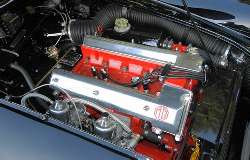 From mid-1500 production to mid 1600 production there was an MGA Twin Cam car. The engine was loosely based on the same Austin B-series engine block but with different location for head studs and extended crankshaft and timing cover to house gear drive to the half-speed shaft and chain drive to the dual overhead cams. This engine had a cross flow head, so the carburetors were on the other side away from the exhaust manifold. The distributor was also relocated on the flip side, mounted on the cast aluminum timing cover and driven at the front end of the half speed shaft. The Twin cam engine was always 1600cc. Very few parts of the Twin Cam engine could fit other MGA engines.
From mid-1500 production to mid 1600 production there was an MGA Twin Cam car. The engine was loosely based on the same Austin B-series engine block but with different location for head studs and extended crankshaft and timing cover to house gear drive to the half-speed shaft and chain drive to the dual overhead cams. This engine had a cross flow head, so the carburetors were on the other side away from the exhaust manifold. The distributor was also relocated on the flip side, mounted on the cast aluminum timing cover and driven at the front end of the half speed shaft. The Twin cam engine was always 1600cc. Very few parts of the Twin Cam engine could fit other MGA engines.
With carbs on the right side, the Twin Cam had the 4-inch air intake hose for the heater on the left, so the heater box was a mirror image assembly and located more to the right. The radiator and steering rack were relocated slightly farther forward, and there was a separate header tank for the cooling fluid mounted on the engine above the exhaust manifold. To allow for the taller Twin Cam engine, the bonnet has a higher dome shape near the front end and different framing underneath. This higher bonnet became standard on the 1500 pushrod cars at the same time and continued through end of MGA production. Due to the time frame of Twin Cam production it could have either the 1500 or 1600 body style (tail lights being the primary difference).

The Twin Cam car used a different gearbox which was derived from the MG ZB Magnette gearbox. The notable external difference is a large rectangular bump on top of the bellhousing, high position for the starter motor, flanged output shaft and two-piece propshaft. The Twin Cam also has Dunlop 4-wheel disc brakes (which were state of the art new and superior when introduced) and separate master cylinders for clutch and brakes. Twin Cam has pin drive knockoff steel disc wheels which are not interchangeable with any other MGA wheels.
There was an option available on the dealer sales ordering check list called Competition Suspension for pushrod engine cars. This was in fact a near complete Twin Cam chassis, with the knockoff steel wheels, Dunlop four wheel disk brakes, and separate master cylinders. This required a variation of the frame for mounting the master cylinders, but no change of the body in the area of the standard heater box, and no change around the radiator, although the steering rack was (usually) set forward a bit like the Twin Cam cars. As such, the Competition Suspension option was quite costly (relatively speaking), and required a different body shell.
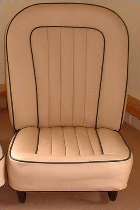 There were optional Competition Deluxe Seats for any MGA. These were available early on but were most commonly installed in Twin Cam cars, some 1500 or 1600 models, and fairly often in the standard engine cars with the Competition Suspension option. Any MGA (other than Twin Cam) could have either spline drive knock off wire wheels or bolt on steel disc wheels. Bolt-on wheels are slightly different starting about January 1959, four months before 1600 production. The rim went one gauge thinner while the center went one gauge thicker, resulting in better strength and less overall weight.
There were optional Competition Deluxe Seats for any MGA. These were available early on but were most commonly installed in Twin Cam cars, some 1500 or 1600 models, and fairly often in the standard engine cars with the Competition Suspension option. Any MGA (other than Twin Cam) could have either spline drive knock off wire wheels or bolt on steel disc wheels. Bolt-on wheels are slightly different starting about January 1959, four months before 1600 production. The rim went one gauge thinner while the center went one gauge thicker, resulting in better strength and less overall weight.
Now I can get to the issue of the "Deluxe" cars. You may notice I keep putting "Deluxe" in quotes. That's because there never was a Deluxe model from the factory. That is, the factory never used the term "Deluxe" as a model designation. Find more information about the specially equipped "Deluxe" cars on the following page.
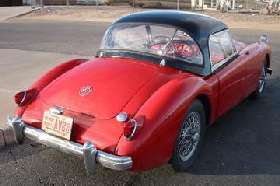
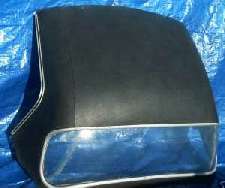
1500-type Aluminum hardtop on left -- 1600-type Fiberglass hardtop on right
There was an optional painted aluminum hardtop for the 1500 roadsters. This top had a shape very similar to the shape of the Coupe roof, but predated production of the Coupe. At beginning of 1600 production there was an optional (less expensive) fiberglass hardtop with notably different shape (flatter on top) and vinyl covering. The two hardtops overlapped production for about 14 months. The remaining aluminum tops were used mostly on the "Deluxe" model cars, and only very rarely on some Twin Cams. Hardtops were also a dealer option, so a fiberglass top might have been installed aftermarket on a 1500 car. Side curtains for use with hardtops had bare metal steel frames painted black early on, later changed to anodized aluminum.
According to factory records Twin Cam roadsters were almost never fitted with a hardtop for factory delivery (although you could buy one from a dealer). There were exactly five Twin Cam roadsters noted in factory records as fitted with the aluminum hardtop at the factory. These were the special works cars built to race at Datona in 1960. Reason for the hardtops there was because race rules that year required a certain volume of interior space that could accommodate a specified size piece of rectangular luggage (in order to be classed as a sport car rather then as a special purpose race car). To accommodate this luggage piece the steel tonneau panel aft of the seats was modified with a slight upward bump at the sides so the luggage could be stowed behind the seats. Of course these were in fact special built race cars, so they never did carry the luggage (other than for tech inspection and certification). But to make the luggage fit the convertible top had to be left out (deleted), so the aluminum hardtops were installed instead.
Mind you this is when 1600 cars were in production being fitted with fiberglass hardtops, and the alloy tops were still overlapping in production. Most of the alloy tops during this period were being installed on the 1600 "Deluxe" cars as a matter of moving (creatively selling) the expensive parts. Because of this practice at the factory the alloy hardtop came to be publicly associated with Twin Cam and "Deluxe" model cars as well as 1500 models (although some late production "Deluxe" cars were fitted with fiberglass hardtops). Today there is a large demand (and short supply) for the alloy tops for restoration and installation on Twin Cam and "Deluxe" cars. This is driving the resale price of the alloy hardtops quite high. One in very nice restored condition sold on eBay for $5200 a few years ago, and tatty condition alloy tops needing restoration regularly sell for over $2000. The fiberglass tops generally sell for about a third of that price, as they are generally only in demand for the standard 1600 model cars.
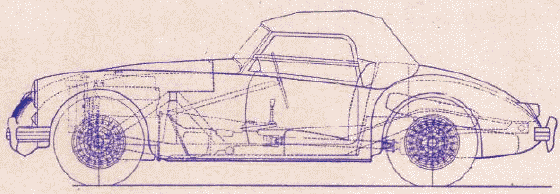
Side elevation drawing indicates relative positioning of components.
Floor level is near bottom of chassis with 6-inches ground clearance
(except exhaust pipe which is not shown).
|